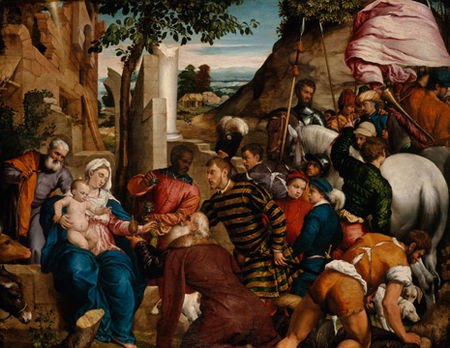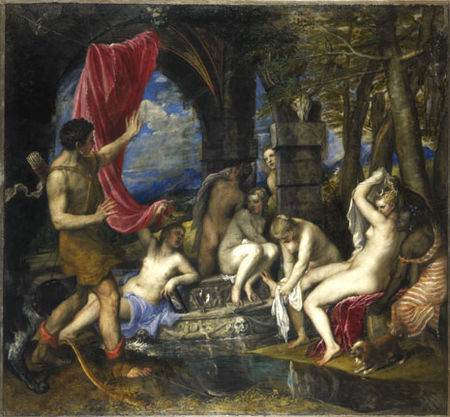“Titian and the Golden Age of Venetian Painting: Masterpieces from the National Galleries of Scotland” @ Minneapolis Institute
Titian (Tiziano Vecellio), Venus Rising from the Sea, Oil on canvas, about 1520. National Gallery of Scotland, Acquired from the Trustees of the 7th Duke of Sutherland, partially in lieu of inheritance tax, with the aid of the Heritage Lottery Fund, The Art Fund (with a contribution from the Wolfson Foundation) and the Scottish Executive, 2003
MINNEAPOLIS, MN.- The Minneapolis Institute of Arts , in conjunction with the National Galleries of Scotland (NGS), the High Museum of Art, Atlanta, and the Museum of Fine Arts, Houston, presents an exhibition of 25 Venetian masterpieces—12 paintings and 13 drawings—including two of the greatest paintings of the Italian Renaissance, Titian’s Diana and Actaeon and Diana and Callisto (1556–59). The exhibition will also include paintings by Tintoretto, Veronese, and Lotto from the NGS collection. The MIA’s presentation of “Titian and the Golden Age of Venetian Painting: Masterpieces from the National Galleries of Scotland” will be on view February 6 through May 1, 2011.
As a complement to the Titian exhibition, the MIA presents a small show of important works on paper from the museum’s permanent collection. From Renaissance woodcuts designed by Titian to views of Venice by Canaletto and Whistler, “Venice on Paper” explores the city through the graphic arts, bringing together five centuries of original prints, drawings, books, and photographs, all made in or about this enchanting "floating" city. Also on view, for the first time since it’s purchase in December, is the MIA’s magnificent View of Venice map. This Renaissance masterpiece, published in Venice in 1500, is a mural-sized birds-eye view of the city, at the time of Titian’s boyhood. Over nine feet wide, this map reveals the design and dazzling technical skill of Jacopo de’Barbari (Italian, c. 1460/70–before 1516).
Titian (Tiziano Vecellio), The Adoration of the Kings, early 1540s. Oil on canvas. National Gallery of Scotland
In addition to Titian’s famous Diana paintings, “Titian and the Golden Age of Venetian Painting” will showcase 10 other paintings that illuminate the depth of the NGS collection of Venetian Renaissance works. These include Titian’s Virgin and Child with St. John the Baptist and an Unidentified Male Saint and Venus Rising from the Sea; Lorenzo Lotto’s Virgin and Child with Saints Jerome, Peter, Francis and an Unidentified Female Saint; Jacopo Tintoretto’s Christ Carried to the Tomb; and Jacopo Bassano’s Adoration of the Magi. The drawings are by Titian, Tintoretto, Veronese, and their contemporaries.
“We are delighted to be a co-organizer of this fantastic exhibition, which will present the cream of the National Galleries of Scotland’s renowned Venetian paintings to our public,” said Kaywin Feldman, director and president of the MIA. “This will be the first time these two ravishing oils—Titian’s Diana and Actaeon and Diana and Callisto—will travel to the United States.”
Titian, Virgin and Child with St John the Baptist and an Unidentified Male Saint, Oil on canvas, transferred from wood, 1517-1520.
The Legendary Diana Paintings Diana and Actaeon and Diana and Callisto “These two paintings have long been recognized as among Titian’s very finest creations and as supreme masterpieces of Venetian Renaissance art,” said John Leighton, director of the NGS. “Their ambitious scale, the masterful unity of color and subject matter, the art-historical significance and their excellent condition all contribute to the fame and reputation of these works.” Titian
Originally commissioned by King Phillip II of Spain as part of a series of six paintings, Titian’s Diana paintings were acquired by the Duke of Orleans in the eighteenth century. Following the French Revolution, the paintings entered the private Bridgewater Collection and passed to the Fifth Earl of Ellesmere (later the Sixth Duke of Sutherland), who placed them on long-term loan to the National Galleries of Scotland in 1945. In 2008, the NGS, together with the National Gallery of London, were given the opportunity to acquire these works in order to keep them in a public collection in the United Kingdom. In less than five months, the NGS and London secured the funds to acquire shared ownership of Diana and Actaeon. Currently, the two institutions are campaigning to acquire Diana and Callisto.
Titian’s Diana paintings were originally part of a series of six large, mythological pictures made for the king, which included Danaë and Venus and Adonis (both now at The Prado, Madrid), Perseus and Andromeda (Wallace Collection, London), and Rape of Europa (Isabella Stewart Gardner Museum, Boston). The Diana paintings, completed when Titian was well into his sixties, depict scenes from Ovid’s Metamorphoses, and represent the Venetian master’s accumulated skill and experience. They were designed as a pair—a stream flows from one painting to the other. The Diana paintings are richer in color and composition than their counterparts in the series
Tiziano Vecelli (c. 1485/90–1576) is considered the greatest of all Venetian Renaissance artists. The technical wizardry, narrative skill, and psychological insight he brought to his works have ensured they remain among the most highly prized of all Renaissance masterpieces. Artistically Titian reached full maturity with his commission for the altarpiece Assumption of the Virgin (1528, now at The Frari, Venice). He created a wide variety of works—portraits, mythological scenes, allegories and altarpieces—and painted for the greatest patrons of his age, including Emperor Charles V and King Philip II of Spain. He also worked for the leading families of Venice, Mantua, Ferrara, Urbino, and Rome.
Oil on canvas, transferred from panel. National Gallery of Scotland, Purchased by Private Treaty with the aid of the National Heritage Memorial Fund, 1984

/https%3A%2F%2Fprofilepics.canalblog.com%2Fprofilepics%2F1%2F0%2F100183.jpg)













/http%3A%2F%2Fstorage.canalblog.com%2F18%2F62%2F119589%2F60463695_p.jpg)
/http%3A%2F%2Fstorage.canalblog.com%2F59%2F52%2F119589%2F54715900_p.jpg)
/http%3A%2F%2Fstorage.canalblog.com%2F33%2F76%2F119589%2F48504843_p.jpg)
/http%3A%2F%2Fstorage.canalblog.com%2F90%2F65%2F119589%2F43507832_p.jpg)